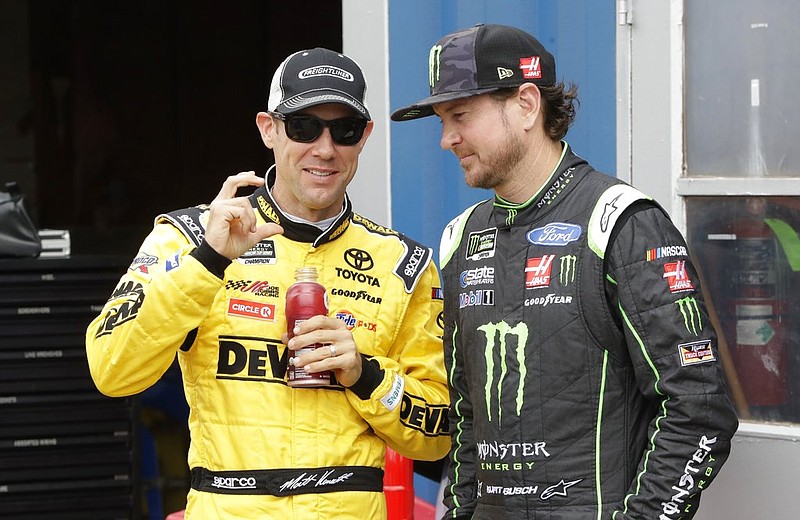We're 15 races into the NASCAR Cup Series season, and we've gotten a snippet of what to expect out of this new format.
Through these 15 races, there's been hard, competitive racing at the end of stages. There's also been a plethora of strategy being played, sometimes too much to keep track of.
So what can we take away from this sample of the new format?
Well, like we knew from the start, there's lots of math involved. So, let's take our seats and open our math textbooks to page No. 2,017.
Math problem No. 1: Jimmie Johnson is in eighth place in the standings and trails second-place Martin Truex Jr. by 191 points with 11 races left in the regular season. Can Johnson catch Truex before the playoffs begin? Yes, if he tallies six more playoff points than Truex while also adding enough regular-season points to pass Truex in those 11 races.
Math problem No. 2: Jamie McMurray has 450 points and zero playoff points. Will he still be in the top-10 when the playoffs start? Not if the season ended today. He'd be 13th. The Joplin, Mo. native has done well this season, just not for this format of racing.
OK, put the book away. That's enough NASCAR math for the day. Unfortunately, there's still 11 races to be calculated into the NASCAR formula that will spit out the 16 drivers it thinks should race for a championship in the 10 playoff races.
Here's more of what we've learned:
You must collect as many stage points as possible. This may sound obvious, but the point is that finishing a race fifth is not as important as being fifth after the first two stages and ending up 14th. In this scenario, the 14th-place finisher receives one more point than the fifth-place finisher. The days of needing a top-5 or top-10 are over. Just get to the front in the first half of the race and you're good. Call it a day.
Stage points get you into the playoffs. Playoff points win championships. Finishing second in all three stages of a race earns 53 points. However, no playoff points are awarded for that type of performance.
Truex has 10 stage wins and two race wins, which means he has 20 playoff points. If the playoffs started today, he'd be leading Kyle Larson by two points. Johnson would be seeded third. Yes, the same driver that's in eighth place in the standings would leap to third. Kyle Busch, who's third in the standings, would be fifth to begin the playoffs. His four stage wins are second most, but the goose egg in the win column doesn't help the M&M's Chevrolet.
Win a race. Obviously. The new format hasn't changed that. Austin Dillon sometimes runs well, most of the time not. But he'd jump from 20th to 12th if the playoffs started today because he won a race on fuel mileage. For drivers not at the level of Truex, Larson or Johnson, try to out-strategize everyone each week and it could land you a top-10 spot in the playoffs. Just one fluke victory passes McMurray, Denny Hamlin, Joey Logano, Matt Kenseth and Clint Bowyer in the playoff seeding. To those drivers just mentioned: Win or NASCAR will send you a card that reads, "Thanks for playing."
So, after sitting through a crash course in NASCAR math and watching the new format in action for 15 races, are you a fan?
I was skeptical when this format was announced, and I'm still a bit skeptical. But the way it looks now, a true champion could come out of all this. It reminds us of the old system when the regular season mattered.
The Chase lessened the importance of the regular season and made the final 10 races the be-all and end-all. Now we have a mix of the old and new. The playoff points earned during the regular season give drivers who do well all season an advantage in the playoffs. It's just like racking up points and building a lead in the old format.
Larson and Truex are always up front each week and they would begin the playoffs with the best chance to win if it started today. But Johnson and Brad Keselowski would be next in line even as inconsistent as they've been.
Busch, Kevin Harvick and Chase Elliott have been more consistent, but today's NASCAR doesn't reward consistency unless it's winning numerous stages and races like Truex. So it's still not perfect and still confusing in some aspects just like when it was announced, and there's no sign that will change. But what has changed is the importance and excitement of the first half of each race. That's what this format was supposed to impact, and it has.
There's hard racing in the top-10 at the end of each stage and pit strategy has been ratcheted up.
The best way to handle this format as a critic is to just sit back and enjoy the style of racing it has created. Fans just want a race worth watching, and so far they are.


